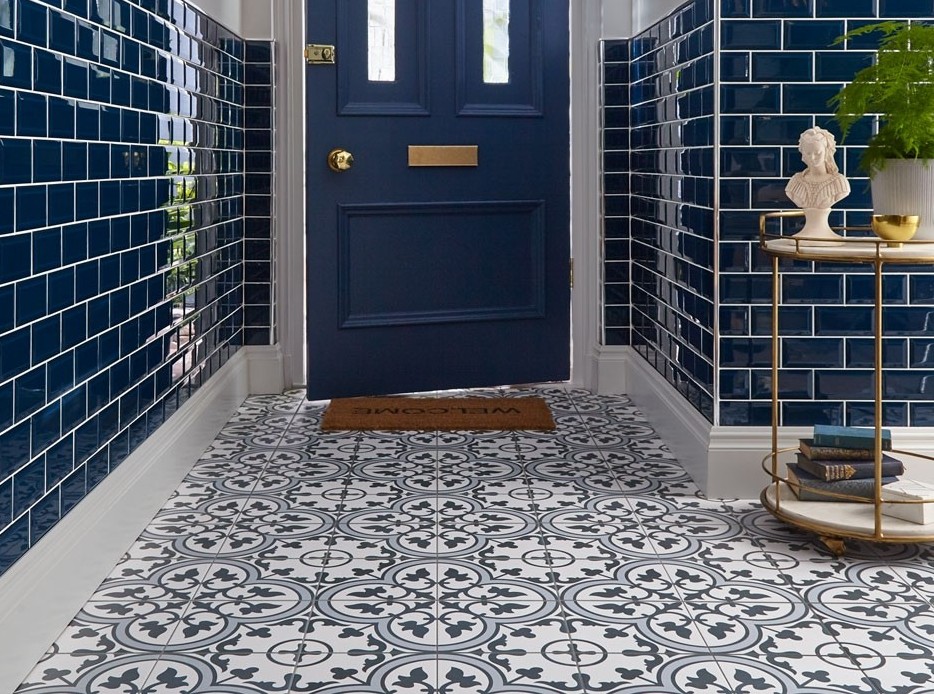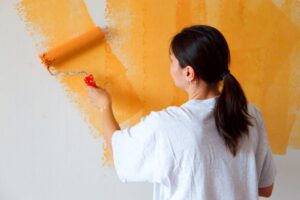Which Flooring Should I Choose? A Complete Guide

No matter which room you’re decorating, it’s important to make the right choice when it comes to the type of flooring you use. It’ll have to last for several years so firstly, you’ll want it to look good and secondly, you’ll want it to withstand the wear and tear you’re going to throw at it!
In this Peachy Guide to Flooring, I’m going to take you through all the different types of flooring you can invite into your home, and tell you which ones are best for the different rooms…
Jump to:
Floor tiles
Carpet
Vinyl flooring
Laminate
Hardwood
1) Floor tiles
Typically, when you think of tiles, you probably imagine boring, plain, cold monochromatic squares. But that’s just not the reality anymore.
Thanks to the latest HD printing technologies, floor tiles come in all manner of guises. Now, you can choose from gorgeous, lifelike stone effect and wood effect designs, along with trendy hexagons, concrete effects and even colourful vintage and Moroccan patterns!
So what are the benefits of using floor tiles in your home? Well, they’re very hard wearing. They won’t scratch and stain as easily as other floor coverings. They’re also easy to clean, which is great news if, like me, you’re not a fan of heavy elbow grease.
Where to use floor tiles
When it comes to which rooms to use tiles in, think about their strengths – they’re durable, so they can take a lot of wear and tear, they’re resistant to stains, they’re resistant to water damage, and they come in anti slip options. So these are the rooms where they’re best suited:
Hallway: Typically, the hallway receives a lot of foot traffic, as it’s where you, your family, and your guests must traipse when coming in and out of the house. Therefore, it’s a good idea to use a durable and hard-wearing floor type in this area, such as floor tiles. Don’t forget – the hallway offers your guests their first impression of your home, so go for something statement and striking, such as encaustic-styled pattern tiles.
Bathroom: When getting in and out of the bath tub or shower tray, despite your best efforts, the floor is always going to get wet. Use water resistant grout, and a tiled floor will keep all the water on its surface, ready for you to mop up! If you’d like to add some extra grip on your bathroom floor, go for an anti-slip tile; these have a slightly textured surface for added friction underfoot. Create a relaxing spa-styled scheme in a bathroom by introducing wood effect and stone effect designs, which have a soothing naturalistic appearance.
Living room: The living room is a sociable space where lots of us eat and entertain guests. Therefore, you’re bound to get the odd spilled drink or tipped plate. Floor tiles form a base that you can easily wipe clean.
Kitchen and utility room: With the washing up and the laundry taking place across these two rooms, it’s not uncommon for the floor to get a bit wet, so again, use floor tiles, which are resistant to water damage, and come in grippy anti-slip options.
Garden: Traditionally when it comes to creating a patio area, we tend to go for paving slabs or wooden decking. The issue is that paving slabs are quite ugly and lifeless, and decking is usually very slippery and dangerous when it gets wet. That’s why anti-slip tiles, which come in a huge selection of designs, are a great option for your outdoor spaces.
Basically, floor tiles are a good all-rounder!

Which floor tiles are best for me?
There are thousands of different floor tiles to choose from, so I’ve narrowed it down to just ten in this post that I hope will inspire you: Top 10 Floor Tiles.
How to tile a floor
If you’re not a confident DIYer, and your budget allows for it, it’s best to bring in a professional tiler – somebody who knows what they’re doing. Check out this guide: How To Hire A Reliable Tradesperson.
However, if you love getting stuck into a spot of DIY, and you’d like to save yourself the cost of a tiler, you can also tackle the tiling project yourself! Here’s a step-by-step tutorial from Walls and Floors: How to Tile a Floor.
2) Carpet
Often seen as the cosiest and comfiest floor covering, carpet comes in a multitude of colours, patterns and textures. It’s soft and warm underfoot and, if you’ve got little ones running around who are prone to the occassional tumble, carpet offers a nice, soft, cushioned landing!
If your home is prone to chilly draughts sweeping across the floor – the type that send a tingle up your spine – then carpet is notorious for helping to keep these at bay! It also helps to contain heat in the room.
Perhaps best of all, if you’ve got noisy downstairs neighbours, or if you’re tired of your stroppy teenager banging about upstairs, carpet also helps to prevent noise from carrying between floors.
Where to use carpet
Due to its nature, carpet is one of the more delicate floor coverings, so you need to be more selective where you use it. Over time, if it’s getting a lot of heavy traffic, it may become downtrodden and threadbare.
Also, consider the function of the room you’re decorating. If it’s a space where there’s a lot of food and drink like a kitchen, dining area or living room, it might not be a great idea to install carpet, since one dropped slice of pizza or a spilt glass of red wine, and that’s a stain you’re going to have some trouble with.
Another thing to factor in is pets and toddlers. Dogs tends to drag a lot of mud into the house, and toddlers can be fairly messy, too – particularly if they get hold of the felt tip pens!
However, a stain on the carpet isn’t the end of the world. Here’s a fab carpet cleaning guide from Cleanipedia: Easy Carpet Cleaning Tips
So, then, where should you use carpet?
Bedroom: A sleepy room where there isn’t too much foot traffic, the bedroom is the perfect cosy nook where you can introduce some warm comfortable carpeting.
Living room: If your house isn’t manically busy, and you don’t have kids or pets running around, the living room is a perfectly acceptable place to install carpet. Top tip: Place a hard-wearing rug under your sofa to help prevent the legs from digging into the carpet.
Dining area: So long as you’re careful with your food and drink, the dining room is another great place for carpet – it’s not used too often, and it’s a warm and welcoming family room where you want something soft and comforting underfoot.
Home office: In the generation of the freelancer, the home office is becoming a more frequent home addition, and carpet is fine to use in this space. Again, put a hard wearing rug under the desk and swivel chair to help preserve the carpet.

Which carpet is best for me?
Similarly to tiles, carpet has exploded into thousands of different patterns and designs; covering everything from wood effects to colourful geometrics. Which carpet to choose depends on the look you’re trying to create. If you want a neutral, calm, relaxed scheme, opt for a simplistic grey carpet. If you want to create more of a statement, go for a more striking focal design.
How to fit carpet
Fitting carpet can be a little fiddly if you don’t know what you’re doing, so you might want to consider bringing in a professional carpet fitter. However, if you’re a competent DIYer and you want to give it a go, here’s a WikiHow guide: How to Install Carpet
3) Vinyl flooring
Vinyl flooring is a growingly popular option when it comes to fitting flooring in your home. But why? What are the benefits to using vinyl?
Well, similar to floor tiles, it’s very functional; it’s hard-wearing, long-lasting, easy to clean, and the higher quality brands are resistant to scratching.
It’s also very quick and easy to install. In fact, vinyl planks click together in much the same way as laminate.
Where to use vinyl flooring
Because it’s water resistant, vinyl makes a great addition to wet areas, such as the bathroom and kitchen. It’ll also wipe clean after spillages or muddy prints. Higher-quality vinyl is also durable enough to withstand high heels and pets. For these reasons, vinyl flooring can be used throughout the home – just not the garden.
Kitchen: Whether you’re clumsy with the washing up, or you can easily mop up any spills from the vinyl’s water-resistant surface.
Bathroom: Don’t worry about making a splash when you’re getting in and out of the bath – the vinyl will keep the water at bay, ready for you to wipe up.

Which vinyl flooring is best for me?
Once again, the type of vinyl you choose from your home is down to your own style, and the colour scheme of your room! I would recommend opting for the click-together planks, however, rather than the vast rolls, since they’re so much nicer to look at, and they’re much easier to install.
How to install vinyl flooring
Vinyl planks form a floating floor, meaning no adhesive is required. You’ll want to use underlay on your substrate, though, to result in a nice even installation, and to cushion any movement in the planks.
The planks click together like laminate, and the thinner varieties can be cut using a Stanley knife! Just slice across the surface with the blade, and snap the plank along the cut.
4) Laminate flooring
A very popular flooring option in millions of homes across the UK, laminate is known for its easy-to-use click-together joints. Typically, it has a wood effect design but more lately, that has opened up to stone effect designs, plain colours and even patterns.
Laminate flooring is made from layers of composite wood that have been heated up and pressed together. Then, the final surface image is laminated over the top.
So what are the benefits of choosing laminate for your floor spaces?
Well, firstly, it’s quite affordable – in fact, it’s often seen as the cheaper alternative to real wooden flooring. Secondly, it’s actually more resistant to scratching than real wooden flooring; because it’s so firm and compressed. Thirdly, it’s pretty easy to install and uninstall, since it’s a floating floor and requires no adhesive – plus all the edges slot together with ease. Fourthly, it’s very easy to wipe clean.

Where to use laminate
Because it’s made from wood composite, it’s not usually advisable to use laminate in wet areas, since the edges might blister if water gets into the cracks. However, in the drier spaces throughout your home, knock yourself out:
Living room: Because it’s easy to wipe clean, laminate makes for a perfect base to a busy family living room where pet mess and spilled drinks are a regular occurrence.
Bedroom: The natural look of laminate is also a welcome addition in a bedroom space – the area where we rest and relax at the end of a hard day – since natural textures and patterns help to create a soothing ambiance.
Hallway: With mud and leaves being traipsed through this space in the wetter gloomier months of the year, the hallway demands a flooring that is easily wipeable, and one that doesn’t stain – so laminate fits the bill!
Kitchen: You might get the occasional spill from a saucepan or from the sink, which is why, again, you want a wipeable floor surface in your kitchen area.
And if you’re laminating the lounge, hallway and kitchen, you might as well do the dining room, too, for a seamless transition between the outdoor spaces!
Which laminate is best for me?
There are hundreds of different designs to choose from when it comes to laminate flooring. Most typically, laminate mimics wood, but as mentioned earlier, it does now also come in stone effect designs and various others.
How to install laminate flooring
Laminate flooring is fairly easy to install since it’s a floating floor and it doesn’t need to be fixed down with adhesive. You simply loose-lay it on top of an underlay, and cut it close to the edges of the room. Laminate can be cut very easily with a regular electric jigsaw.
5) Hardwood flooring
Made from solid wood, hardwood flooring is by far one of the most luxurious flooring types, and it’s common in older traditional homes. If you’re renovating a Victorian or Edwardian build, it might be in-keeping with the property to stick to natural hardwood flooring. On the other hand, if you want to create a traditional look in a more modern build, you may still consider hardwood flooring.
So what are the benefits of choosing hardwood flooring? Well, it’s beautiful, and it’s the real deal, so it’ll always trump wood-effect imitations in the looks department. Furthermore, it usually holds its value when it comes to getting your home valued.
There are various different types of hardwood flooring (oak, beech, etc) and they grow in price the more exotic the wood.
It’s also a growing trend to create a characterful, shabby-chic look by using reclaimed wood. This is wood that has been salvaged from demolition sites, old shacks, and even old boats. It’s then repurposed into new flooring! The result is a mish-mash of colours and textures, resulting in a ton of personality.

Where to use hardwood flooring
Hardwood flooring is quite costly and it’s not very resistant to scratches, so it’s advisable to use it in areas that don’t receive much of a battering. If you have pets, avoid using hardwood flooring in areas where they’re likely to run around, since their claws are quite capable of scratching the flooring. Similarly, avoid it in areas where chair legs are dragged across the floor, such as the dining area (you can always apply felt pads to the feet, but they do peel over time).
It’s always a good idea to avoid using natural wood in the bathroom, as the moisture won’t have a good effect on it over time.
So that leaves:
Living room: If you don’t have pets or wreckless toddlers scurrying around the lounge, then it’s a perfectly acceptable room to install some gorgeous hardwood flooring.
Hallway: So long as your home isn’t too busy, and it’s pet-free, the hallway is a swell place for hardwood flooring.
Kitchen: If the floor in the kitchen if kept dry, and if you don’t have any pets, then there’s no issue in installing hardwood flooring here.
Bedroom: One of the most quiet and restful rooms in the home, hardwood flooring doesn’t have too much threat of becoming scratched in the bedroom.
Which hardwood flooring is for me?
The type of wood you choose when picking out your hardwood flooring all depends on the character you’re trying to achieve in the home. If you want something traditional or eclectic, then a dark oak or walnut would do the trick. Alternatively, if you want to create a brighter modern space, go for a light oak.
To make more of a striking statement with your floor, break away from planks – consider exciting parquet and herringbone designs instead!
How to install hardwood flooring
If you’ve got the budget for hardwood flooring, it’s likely worth hiring in professional installers who can fit it without damaging any. Alternatively, if you’re a stubborn DIYer and you’ve got your heart set on doing it yourself, most hardwood flooring slots together similarly to laminate.
So which is the best flooring type overall?
If you look through the strengths and weaknesses of the flooring types above, floor tiles come out on top, since they’re the only floor covering that perfectly cater for all settings throughout the home and garden!



